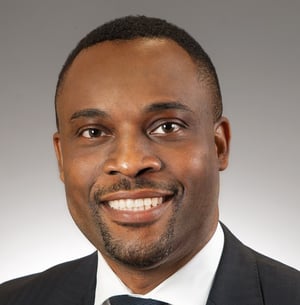By Alex Pappas, updated in August 2021 based on interview conducted in June 2020.

Name: Bola Olusanya
Current Role: CIO, The Nature Conservancy (TNC)
Previous Experience:
MD of Asset Allocation and Portfolio Strategy, Key Private BankMD, Public Equities, Strategic Investment Group
MD, Investments, Vanderbilt University
Academics: MBA, Finance Emory University
MS, Computer Science University of Lagos
BS, Computer Science University of Ibadan
Accolades: 2015 recipient of Institutional Investor's “Investor Intelligence award for endowment and foundation risk management"; 2013 & 2014 ai-CIO's “40 Under 40.”
Activities Outside of Work: I have two young boys (ages 9 and 12) who keep me busy. They’re both huge basketball fans so we’re always playing, especially during this lockdown. I’m ashamed to admit it, but they’re both much better than me. That’s what old age does to you! I like listening to podcasts, reading biographies, writing poems (I’ve published two collections already), watching tennis, documentaries and the occasional Netflix binging.
As a new CIO, how did you get up to speed on your current portfolio? How does your organization use factors to manage the portfolio?
I have spent my first three months getting a deep understanding of our investment portfolio. This has involved having Zoom meetings and calls with every manager in our public investment portfolio and a handful of our private investment managers. It’s important to understand the history of these managers, the roles they play within our broader portfolio as well as their ability to generate consistent risk-adjusted return. I’m also very fee-conscious, especially given the low-return world we live in. So, it’s important for the investment managers we partner with to have reasonable management fees and incentive fees, where they exist, need to be aligned with TNC’s goals.
Naturally, ESG and impact investing are important elements of TNC’s investment philosophy. As I’ve been engaging with our investment managers, I have been keeping an eye on their efforts at being better stewards of the environment, how they are embracing a socially diverse workplace and culture, and how they are helping to implement strong corporate governance practices in the businesses they invest on TNC’s behalf.
These qualitative due diligence and re-underwriting exercises have been very important, but equally important has been the quantitative analysis of the drivers of risk and return within our overall portfolio and the individual managers. I have relied on Venn’s factor-based risk and return attribution tools to unearth critical insights that have helped shape some of the decisions we have been making since I joined. For example, I’ve been able to quantitatively identify managers that are truly skilled, whose excess returns are not driven by exposures to risk factors. The converse is also true, but the good news is that these managers are in the minority.
I have a small but exceptional internal team that has made my transition into this role almost seamless, despite the challenging circumstances. I am also very fortunate to be working with investment advisors that share not only my passion for TNC’s mission, but also my vision for the portfolio. Lastly, and most importantly, TNC has an incredible Investment Committee, comprising of talented investment professionals and business leaders whose guidance and insights have been invaluable, given my short tenure on the job and the extraordinary times we live in.
Have you noticed a shift in focus on factors versus traditional asset class diversification?
There has definitely been a semantic shift in the focus on factors. I think true adoption and implementation of a factor-based asset allocation framework is still in its infancy. What I think is undeniable is that the investment industry has recognized that certain risk factors permeate across various asset classes and it is important to group these risk factors together and make investment decisions accordingly. So, what I have seen folks do is group private equity, venture capital, public equity and in some cases, high yield/distressed investments as growth assets. Similarly, hedge funds are classified as diversifiers, while traditional fixed income investments and cash are grouped as preservation assets. While these classifications are an improvement over the traditional asset class framework, they still fall far short because of the lack of quantitative rigor to truly understand drivers of risk and return.
I think a tool like Venn should help increase the adoption of the risk factor framework because of its ease of use and intuitiveness of the results. The next five years should be exciting for allocators who embrace this relatively new paradigm as it will force us to focus on issues that are most impactful to our portfolios – risk factors – rather than less impactful issues like asset classes, individual managers, individual stocks or individual bonds. The result will be better decisions, better portfolios and better outcomes.
Does TNC make use of returns and/or holdings-based analysis when monitoring the portfolio? What do you see as the pros/cons of each?
Yes. We use Venn for our returns-based analysis while we are in the process of on-boarding a tool for holdings-based analysis. The elegance of returns-based analysis is its simplicity and applicability to multiple asset classes or strategies. All you need are the historical returns. Two main shortcomings are the fact that you need to have several months of returns to make any meaningful conclusions and the fact that if you’re trying to understand regional, sector or industry exposures at a given point-in-time, you are better off running a holdings-based analysis.
The major shortcoming of holdings-based analysis is that it can be complex and is only effective when analyzing long-only equity investments (and fixed income in some cases). Hedge funds, due to their limited holdings-based transparency, are often not suitable for holdings-based analysis. The same goes for private investments in general.
That said, both are important, and like the parable of the blind men and an elephant, they provide different but useful perspectives of the portfolio.
What are the challenges CIOs and other institutional leaders face today that perhaps they didn’t face in the past?
The biggest challenge facing CIOs and institutional leaders today is how to generate the required returns to meet their liabilities or long-term obligations in what is undoubtedly a low-return world. Even before COVID-19, the myriad efforts by global central banks to lower short-term borrowing rates and pump an inordinate amount of liquidity into the financial system (through quantitative easing and other programs) has caused unprecedented imbalances. For pension funds, their liabilities have ballooned, and endowments and foundations are facing steep hurdles to meet their inflation-adjusted spending rates. As a result, investors have been forced to move up the risk curve and a focus on valuations has mostly gone unrewarded. These issues have been exacerbated during the current health and economic crisis, so I expect a post-COVID world would likely prove to be even more daunting for allocators.
How did you start your career in investment management?
I studied computer science at the undergraduate and graduate levels, so investment management was the last career on my mind during those years. Even when I worked in corporate banking in Nigeria, I still didn’t foresee myself helping institutions to manage their investment assets. My big break came while I was getting my MBA at Emory University. I was lucky to get the opportunity to work for the investment office at Emory, thanks to Matthew Wright, who later became CIO at Vanderbilt and hired me there too.
Investment management has been an incredible career for me. There are two things I love the most about my job. First is the fact that you are constantly learning and growing. Every geopolitical event in the world, even in remote corners, has an impact on your investment portfolio. You need to compartmentalize them and focus on those that will have the greatest impact, while not losing sight of your long-term goals. This is a very complex problem to solve especially because it involves predicting human behavior. It requires humility to know that you will be wrong a lot of times. However, if you’re following a disciplined investment process grounded in theory, practice and experience, you know that you have a high probability of reducing the frequency and the magnitude of your errors.
The second, and perhaps the more important reason I love this industry, and my current role at TNC specifically, is that every day, if I do my job well, I am helping to achieve the organization’s mission to protect the lands and waters that all life depends on. I do believe that climate change is an existential threat to humanity and the work that my colleagues at TNC and other environmental organizations are doing, is critical to ensuring that our planet survives. The performance of our long-term investment portfolio, which I oversee, plays an important role in supporting this mission. So, I wake up every morning fully energized and ready to do my part in this critical mission.
Disclaimer: The Venn subscriber featured in this article was not compensated for their statements. As a Venn subscriber, their use of portfolio analytics or other Venn features and their experience could differ from your organization’s due to their particular use of Venn, the version of Venn used, or other factors. Not all subscribers will be equally satisfied. The person providing this testimonial was selected based on a variety of factors, some of which are subjective. This document is for informational purposes only. Not an offer to buy or sell securities. Click here for Important Disclosure and Disclaimer Information.
The information contained in this article is provided for general informational and educational purposes only, and should not be construed as investment advice. The contributor to this material is associated with a client of Two Sigma Investor Solutions, LP (“TSIS”). Neither TSIS nor its affiliates have compensated the contributor for his statements. The statements from the interview have been edited and reformatted by TSIS with the contributor’s approval. Unless otherwise noted, the contributor’s statements do not represent the actual views or opinions of TSIS or its affiliates, or any officers, directors, or employees thereof.
This article is not an endorsement by Two Sigma Investor Solutions, LP or any of its affiliates (collectively, “Two Sigma”) of the topics discussed. The views expressed above reflect those of the authors and are not necessarily the views of Two Sigma. This article (i) is only for informational and educational purposes, (ii) is not intended to provide, and should not be relied upon, for investment, accounting, legal or tax advice, and (iii) is not a recommendation as to any portfolio, allocation, strategy or investment. This article is not an offer to sell or the solicitation of an offer to buy any securities or other instruments. This article is current as of the date of issuance (or any earlier date as referenced herein) and is subject to change without notice. The analytics or other services available on Venn change frequently and the content of this article should be expected to become outdated and less accurate over time. Any statements regarding planned or future development efforts for our existing or new products or services are not intended to be a promise or guarantee of future availability of products, services, or features. Such statements merely reflect our current plans. They are not intended to indicate when or how particular features will be offered or at what price. These planned or future development efforts may change without notice. Two Sigma has no obligation to update the article nor does Two Sigma make any express or implied warranties or representations as to its completeness or accuracy. This material uses some trademarks owned by entities other than Two Sigma purely for identification and comment as fair nominative use. That use does not imply any association with or endorsement of the other company by Two Sigma, or vice versa. See the end of the document for other important disclaimers and disclosures. Click here for other important disclaimers and disclosures.
This article may include discussion of investing in virtual currencies. You should be aware that virtual currencies can have unique characteristics from other securities, securities transactions and financial transactions. Virtual currencies prices may be volatile, they may be difficult to price and their liquidity may be dispersed. Virtual currencies may be subject to certain cybersecurity and technology risks. Various intermediaries in the virtual currency markets may be unregulated, and the general regulatory landscape for virtual currencies is uncertain. The identity of virtual currency market participants may be opaque, which may increase the risk of market manipulation and fraud. Fees involved in trading virtual currencies may vary.


